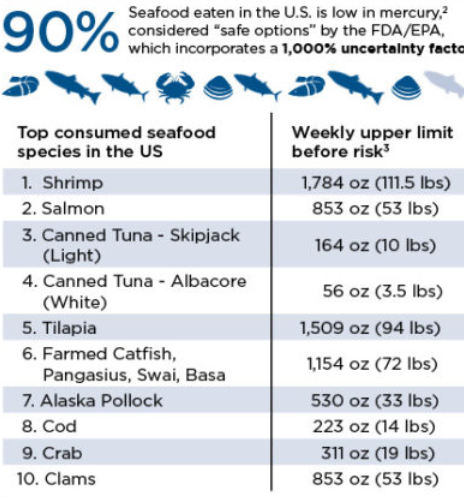Since the original FDA consumption guidelines were developed in 2000, Americans have been concerned about mercury in seafood. These early guidelines were issued out of caution when research wasn’t available. However, studies conducted since then have shown fears of mercury toxicity from eating seafood are largely unfounded. These studies highlight the significant benefits of eating seafood and the potential risks of not consuming enough. Despite this, many Americans are unaware of the current research and remain concerned, especially the groups that would benefit the most from eating seafood: pregnant and lactating mothers, and children.
Current Facts About Mercury – Seafood is Safe!
- The FDA updated its advice on seafood consumption in 2019 and 2021, specifying that fish are part of a healthy eating pattern and provide key nutrients during pregnancy, breastfeeding, and early childhood to support development.
- According to the NFI Mercury Fact Sheet, there are no confirmed cases of methylmercury toxicity in the U.S. from consumption of commercial seafood. However, it is estimated that low seafood consumption contributes to 84,000 preventable deaths annually in the U.S.
- Seafood is rich in selenium, a required nutrient supporting brain function while detoxifying mercury from all dietary sources.
Among the top consumed seafood species in the U.S., a massive (nearly impossible) amount would need to be consumed in a week before any mercury risk.
 Why Is Eating More Seafood Important?
Why Is Eating More Seafood Important?
Fish is one of the healthiest foods you can eat. That’s because it’s a great source of protein, micronutrients, and healthy fats — all of which have numerous benefits for your overall health. There are hundreds of types of seafood you can select from that are both delicious and extremely safe to eat. The risk of not eating enough seafood far outweighs any potential concern over mercury exposure. Seafood is a superfood!
- Eating seafood 2-3 times a week reduces risk of death of any health-related cause by 17%.
- Seafood is a nutrient-packed food, rich in omega 3‘s that provides benefits to:
- Brain health, including reduced depression
- Heart health
- Improved fertility/virility for men
- Healthier pregnancies for women, resulting in smarter kids
- Pregnant women need the nutrients in seafood for development and current FDA dietary guidelines recommend pregnant women eat at least 2 servings of seafood a week
- Mothers who ate more than 12 ounces of seafood per week have babies with higher IQ, by 7.7 IQ points
- Sufficient intake of omega 3’s during pregnancy can reduce the risk of pre-term birth by up to 66%
Sources:
- Selenium, Mercury, and Health Benefit Values of Pelagic Ocean Fish of the Central North Pacific by Nicholas V. C. Ralston 1,*,J. John Kaneko 2 and Laura J. Raymond https://www.mdpi.com/2410-3888/10/4/158
- Spiller P, van Wijngaarden E, Adams HR, Strain JJ, McSorley EM, Mulhern MS, Conway MC, Yeates AJ, Carrington C, Bolger PM, Morgan KM, Taylor CM, Ralston NVC, Crawford MA, Hibbeln JR, Brenna JT, Myers GJ. Net effects explains the benefits to children from maternal fish consumption despite methylmercury in fish. Neurotoxicology. 2023 Dec;99:195-205. doi: 10.1016/j.neuro.2023.10.010. Epub 2023 Oct 20. PMID: 37866693. https://pubmed.ncbi.nlm.nih.gov/31669935/
- FDA (Updated 2024). https://www.fda.gov/food/consumers/advice-about-eating-fish
- NFI (2025). https://aboutseafood.com/resource/nfi-mercury-fact-sheet/
- The Preventable Causes of Death in the United States: Comparative Risk Assessment of Dietary, Lifestyle, and Metabolic Risk Factors Goodarz Danaei, Eric L. Ding, Dariush Mozaffarian, Ben Taylor, Jürgen Rehm, Christopher J. L. Murray, Majid Ezzati Research Article | published 28 Apr 2009 PLOS Medicine
- https://doi.org/10.1371/journal.pmed.1000058
- FDA (2014). “A Quantitative Assessment of the Net Effects on Fetal Neurodevelopment From Eating Commercial Fish.”
- FAO/WHO (2011). Report of the Joint FAO/WHO Expert Consultation on the Risks and Benefits of Fish Consumption. Rome, Food and Agriculture Organization of the United Nations; Geneva, World Health Organization, 50 pp.
- S.E. Carlson, B.J. Gajewski, C.J. Valentine, S.A. Sands, A.R. Brown, E.H. Kerling, S.A. Crawford, C.S. Buhimschi, C.P. Weiner, M. Cackovic, E.A. DeFranco, D.P. Mudaranthakam, L.K. Rogers,



Leave a Reply